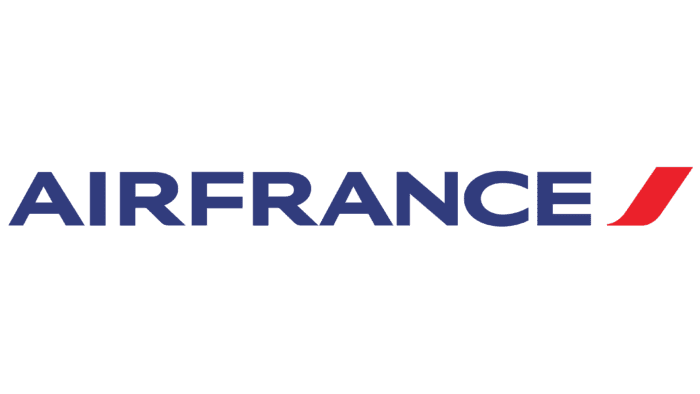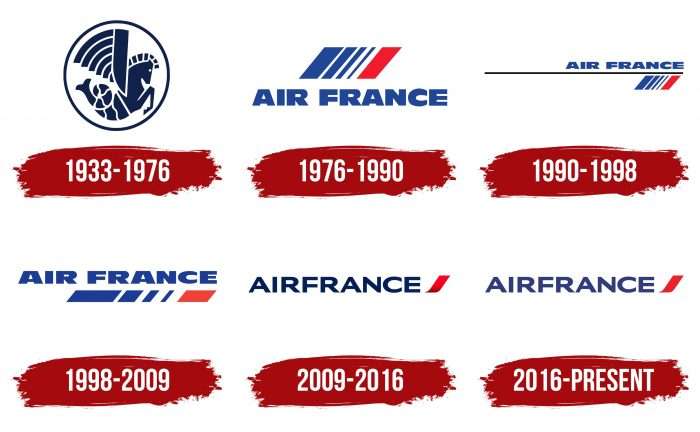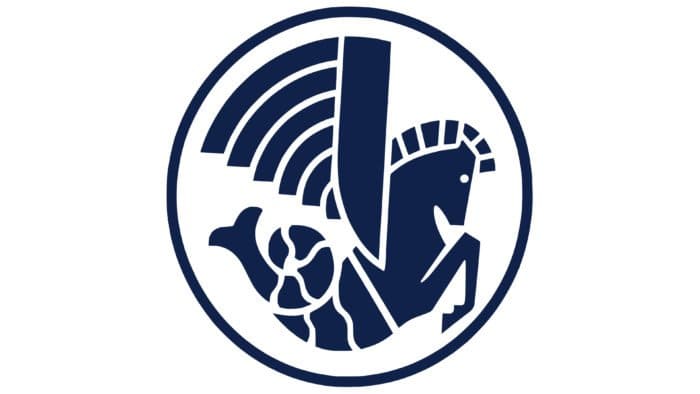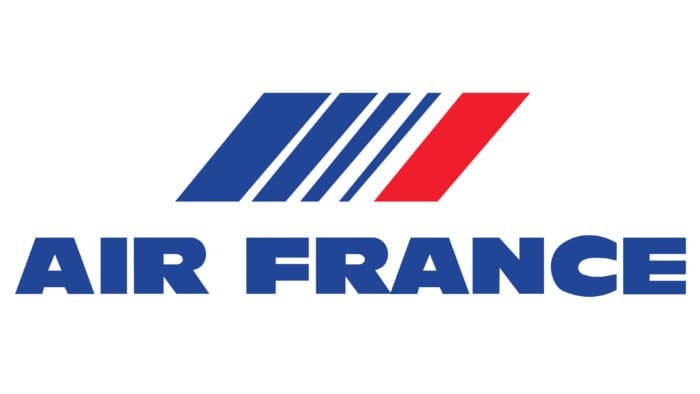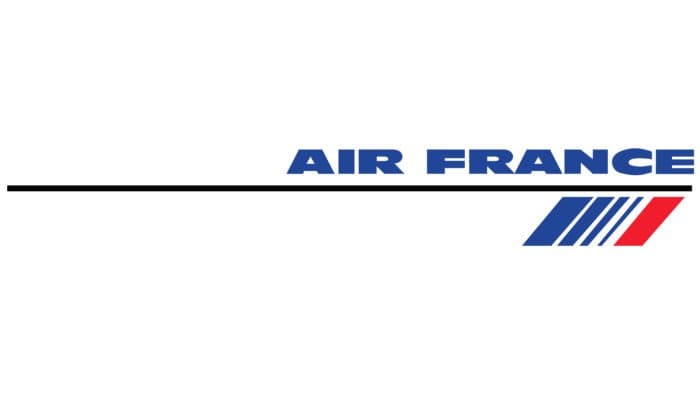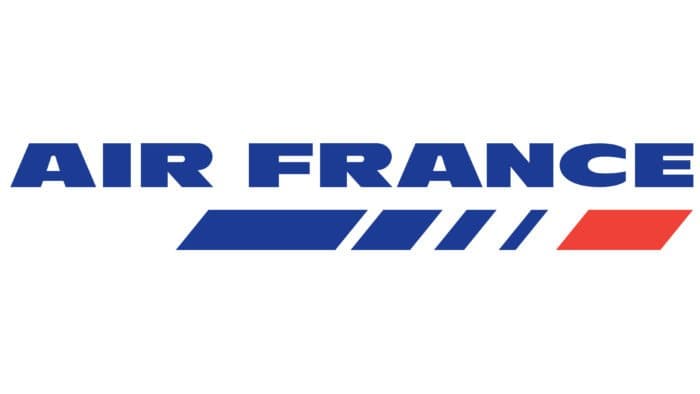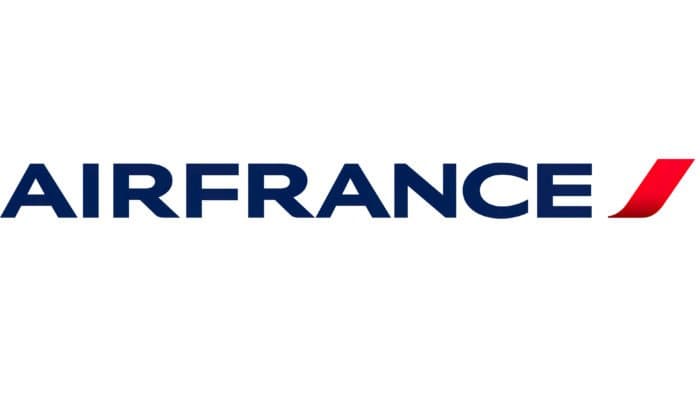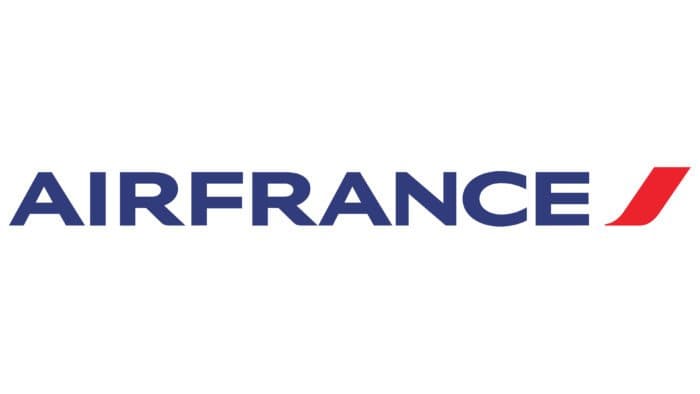The French airline Air France utilizes a practical logo. The inscription is the name, and the red stripe symbolizes leadership. The Air France logo reflects confidence, comfort, and reliability, as evidenced by the dense arrangement of uppercase letters. The theme of the sky is reflected in the emblem’s color.
Air France: Brand overview
The history of Air France, one of the biggest and oldest airlines in the world, dates back almost a century. Several French airlines, including Air Orient, Air Union, Compagnie Générale Aéropostale, Compagnie Internationale de Navigation Aérienne (CIDNA), and Société Générale de Transport Aérien (SGTA), merged to form the corporation on October 7, 1933. The French government started this merger to establish a domestic airline that could rival the country’s leading foreign carriers at the time.
During its initial years of operation, the company primarily served European nations and former French possessions in Asia and Africa. The airline’s fleet comprised French-built aircraft, including the Blériot 155, Dewoitine D.338, and Potez 62. The expansion of its European route network started in 1935 when it began operating flights from Paris to London.
Its aircraft were commandeered for military use, and its operations were interrupted during World War II. Following France’s liberation in 1944, the airline started operating again and reconstructed its network of routes.
This company was one of the first airlines to use Douglas DC-4 aircraft for routine transatlantic flights in 1945. The airline began operating flights to South America and the French West Indies in 1946, as well as flights to New York.
In the 1950s, it opened new routes to South Africa, Japan, and Hong Kong as part of its ongoing international route network expansion. Additionally, the airline started flying jets, like the Boeing 707 and Sud Aviation Caravelle, which shortened trip durations and improved customer comfort.
The company updated its fleet in the 1960s by adding Boeing 727 and 747 aircraft. As one of the first Western airlines to travel to China and the Soviet Union, the airline began serving these nations.
Growing fuel prices and heightened competition from other airlines in the 1970s put the business in financial jeopardy. Upon its partial nationalization in 1976, the French government acquired 98% of the company’s shares.
Throughout the 1980s, the company added routes to cities in Europe, Asia, and the Americas as part of its ongoing network expansion. The airline recently started flying Airbus A300 and A310 planes, renowned for their comfort for passengers and fuel efficiency.
Due to rising competition from low-cost carriers and the deregulation of the European aviation market in the 1990s, it faced new difficulties. In 1994, the airline joined the SkyTeam alliance with well-known carriers, such as Korean Air, Delta Air Lines, and Aeroméxico.
The company procured Airbus A318, A319, A320, and A321, along with Boeing 777 and Airbus A330 aircraft, throughout the 2000s as part of its ongoing fleet modernization efforts. The introduction of Transavia France, its low-cost airline, further solidified its position in the low-cost sector.
One of the biggest aviation holding businesses in the world, the Air France-KLM Group, was formed in 2004 through the company’s merger with the Dutch airline KLM. As a result of this combination, both airlines were able to grow their routes and improve their operational effectiveness.
The company expanded its route network in the 2010s, adding additional stops in the Americas, Asia, and Africa. The airline started operating aircraft from the next generation, like the Airbus A350 and Boeing 787 Dreamliner, renowned for their increased passenger comfort and fuel efficiency.
After 2010, it kept growing despite the many obstacles and problems the aviation sector faced.
The airline unveiled a revised corporate identity in 2011, with new aircraft liveries and a logo. This rebranding highlighted the company’s modern and dynamic nature, dedication to innovation, and superior service.
When it started flying these planes in 2012, the company was among the first airlines in Europe to employ the sleek and economical Boeing 787 Dreamliner. This allowed it to provide travelers with a new standard of luxury and service on long-haul routes.
The airline celebrated its 80th anniversary in 2014, solidifying its position as one of the most venerable and established airlines globally. Several unique promotions and events were held with the anniversary for staff and passengers.
The company first flew the largest passenger jet in the world, Airbus A380s, in 2015. In addition to increasing operational effectiveness on heavily traveled routes, the A380 offered passengers exceptional luxury and service.
The airline debuted “Le nouveau Business,” a new business class cabin, in 2017. Designed in association with well-known designers, this cabin features entirely flat mattresses, huge TVs, and first-rate service in its suites.
The company started to phase out its Airbus A380 fleet in 2018 in favor of more affordable wide-body aircraft like the Boeing 787 and Airbus A350.
The airline took delivery of its first Airbus A350-900 aircraft in 2019. This contemporary aircraft, furnished with the newest gadgets and entertainment systems, offered long-haul passengers even more comfort and service.
In 2021, the company continued to provide dependable and secure air transportation, even in the face of the pandemic’s continuing effects. In response to the new circumstances, the airline instituted stringent safety and hygienic measures within its planes and airports.
Meaning and History
The emblem features Hippocampus – a mythological creature resembling a winged horse with a fish’s tail. Legend has it to be the fastest animal, which the ancient gods harnessed to their chariots. The Nereids also rode it. Air France chose it as an embodiment of maximum speed for its logo.
What is Air France?
Air France is the world’s oldest national airline, and it has been operating since 1933. It has over 300 planes and flies to 320 cities in 116 countries, serving around 50 million passengers annually. Paris Charles de Gaulle and Orly airports are its main hubs. The company’s headquarters are in Tremblay-en-France. It is one of the world’s oldest airlines and a member of the SkyTeam alliance. It is part of the European holding Air France-KLM; it was France’s main airline before merging with it.
1933 – 1976
The first corporate logo of the French airline looked like a heraldic symbol depicting Hippocampe Aline. In the center of a white circle was a winged horse with a fish’s tail. Wide lines emanating from its wings give the emblem dynamism and a sense of movement. All elements are dark blue, including the border.
1976 – 1990
In 1976, a new era of brand symbols began without the mythical creature. Designers changed it to a slightly tilted and elongated rectangle with several stripes, like a barcode. Below it is the inscription “Air France,” done in bold font. Like the national flag, the color palette is white, red, and blue.
1990 – 1998
In 1990, developers introduced an updated visualization of the logo. All elements remained the same, but their proportions and placement changed. The company name is now above the graphic sign under a thin black stripe. It separates it from the rectangle located in the lower right part.
1998 – 2009
During this period, designers made another version of the logo. They removed the black line and shifted the bottom element, making it wide. This allowed the stripes to be made short, resembling a parallelogram. The geometric figure group is written in large letters under the “Air France” inscription.
2009 – 2016
This version’s font became much clearer: the letters look thinner and more elegant. The rectangle was replaced with a small red ribbon shaped like a flat parallelepiped. In addition, the two words are combined into one. The primary colors are blue and red.
2016 – today
In 2016, the logo’s palette was softened: the “Air France” phrase acquired a pastel shade.
Air France: Interesting Facts
Air France is a famous airline from France that has been around for a long time and is known for flying people all over the world in a fancy way.
- How It Started: Air France was formed in 1933 when a few smaller airlines joined. The oldest part of it started in 1919.
- Big Planes: They were among the first to use the Airbus A380, a huge plane that shows they like new things and making trips comfortable for people.
- Super Fast Flights: They used to fly the Concorde, a super fast plane that could get you from Paris to New York in less than 3.5 hours. But they stopped using it in 2003.
- Flies Everywhere: Air France flies to many places — hundreds of spots in over 90 countries, making it a big deal for flying around the world, especially in France and Europe.
- Teamwork: They helped start SkyTeam in 2000, a group of airlines that makes it easier for travelers to go to many places with different airlines working together.
- Made History: They’ve been part of big moments in flying, like the first flight from Europe to North America after World War II.
- Fancy Flying: Air France gives people a fancy experience with great food, wine, and comfy seats, especially in First and Business classes.
- Joining Forces with KLM: In 2004, Air France and KLM, a Dutch airline, merged. They’re a big group but still fly under their names.
- Loves Art and Culture: They’re into French art and culture, working with artists and designers to make everything from uniforms to what they use to serve food look cool.
Air France is all about bringing new ideas to flying, making it comfy and fancy for travelers, and spreading French style and culture worldwide.
Font and Colors
Since Excellence In Motion is the official font on the French carrier’s website, experts suggest using an enlarged version of the logo. It’s also similar to other fonts used at different times, such as Mr. Eaves Mod Heavy, LCT Picón Extended Extra Bold, Adrianna Extd ExtraBold, and Venn Extended XBold.
The logo’s palette features the classic colors of the country’s flag to which the airline belongs: red, white, and blue. The tricolor emphasizes the airline’s legal affiliation and embodies its historical heritage.
FAQ
What is the horse in the Air France logo?
The Air France logo features a winged seahorse, a unique symbol combining elements from Greek and Vietnamese mythology. The head of the seahorse represents Pegasus, a flying horse from Greek stories that symbolizes wisdom and fame.
The winged seahorse is a powerful logo for Air France, representing its goals of elegance and speed and its efforts to connect different parts of the world. It plays a key role in Air France’s brand, showing its dedication to excellence and embracing a diverse global heritage. The logo supports the airline’s mission to bring the world closer together with its international flights.
What is Air France known for?
Air France, founded in 1933, has played a major role in developing the aviation industry. The airline helped pioneer long-distance flights early on, connecting remote parts of the world and making global travel easier. This expansion started in the 1930s, reaching places like Africa, Asia, and the Americas.
Air France is well-known for using the Concorde, a fast supersonic plane that started flying in the 1970s. The Concorde could cross the Atlantic much faster than regular planes. Even though it stopped flying in 2003, it remains a symbol of Air France’s dedication to using advanced technology.
The airline focuses heavily on safety, customer service, and comfort. It updates its planes with the latest technology to improve the travel experience. Today, Air France has one of the most modern fleets in the world.
Air France leads in adding new passenger services, like better in-flight entertainment systems and more comfortable seating. The airline is recognized for its continuous innovation, excellent service, and ability to connect different parts of the world.
What is the motto of Air France?
Air France has changed its slogan over the years to better reflect its brand. The airline used “Making the Sky the best place on earth” for fifteen years before switching to “Air France, France is in the air.” The first slogan highlighted how Air France aimed to make flying a great experience, focusing on comfort, quality, and enjoyment. It suggested flying with Air France could be even more delightful than staying on the ground.
The current slogan, “Air France, France is in the air,” has a double meaning. It points to Air France’s presence in the skies and brings French culture into its services. This slogan reminds travelers that flying with Air France means experiencing French hospitality, cuisine, and style. It shows the airline’s strong connection to French culture and its role in promoting French excellence in food, fashion, and more. This slogan helps position Air France as an airline and a representative of French culture globally.
What are the colors of Air France?
Air France’s primary colors are blue and white, symbolizing the airline’s heritage and identity. Blue represents professionalism, reliability, and trust, which are important qualities that the airline showcases. White adds a sense of cleanliness and simplicity, emphasizing safety and comfort, which are crucial in aviation.
Air France added red to its color scheme. This red energizes the traditional blue and white colors, bringing a dynamic and energetic feel to the brand. Red captures attention and highlights important features, adding vibrancy and excitement to the visual identity.
This new combination of colors keeps Air France’s classic look while giving it a modern, lively twist. The red, blue, and white mix reflects the airline’s aim to stay current and appealing in the competitive airline industry.
What does the Air France airline’s logo represent?
The Air France logo is designed to reflect the airline’s identity and dynamic nature. It prominently displays the airline’s name for brand recognition and includes a unique red ribbon shaped like a curved parallelogram. This form is decorative; it symbolizes movement and speed. The ribbon’s curvature suggests fluid motion, and its forward-leaning shape implies progress and fast service, mirroring the speed and efficiency of air travel.
The color red in the ribbon is meaningful, as red is linked with energy, passion, and action. In the logo, red helps to catch the eye while emphasizing the airline’s energetic and dynamic nature. This is important for conveying Air France’s strengths and active presence in the global aviation market. The logo, with its bold text and vibrant red ribbon, communicates Air France’s commitment to fast and efficient service.
Is Air France a private company?
Air France is a private company, yet it is public because its shares are traded on the stock market. This allows both private investors and the general public to own a part of the airline.
Air France must follow strict regulations and be transparent with its financial information as a public company. This is important because it shows shareholders and potential investors how the company performs. Selling shares helps Air France raise money for business activities, growth, and improvements.
Is Air France part of KLM?
Yes, Air France is part of KLM. In 2004, Air France merged with KLM Royal Dutch Airlines from the Netherlands to form a new company called Air France-KLM SA. This company oversees both the Air France and KLM brands.
The merger brought together two of Europe’s biggest and oldest airlines. Their goal was to strengthen their presence in the global aviation market. They planned to do this by making their operations more efficient, reaching more destinations, and improving their services by sharing resources and working together strategically. Today, Air France-KLM is one of the top airline groups in the world. Air France and KLM still operate under their names but benefit from being part of a larger, more efficient network.
Who owns Air France?
Several key players own Air France. The French government holds the largest share through the State Participation Agency, which shows how important the airline is to the country. China Eastern Airlines owns close to 10% of Air France, which helps European and Asian airlines work better together.
The Dutch government owns a slightly smaller share than China Eastern, linking Air France closely with KLM, another major airline. This helps them operate more efficiently and reach more destinations. Based in the U.S., Delta Air Lines owns about 5.8% of Air France. This ownership strengthens the connection between flights across the Atlantic, making travel smoother for passengers.
